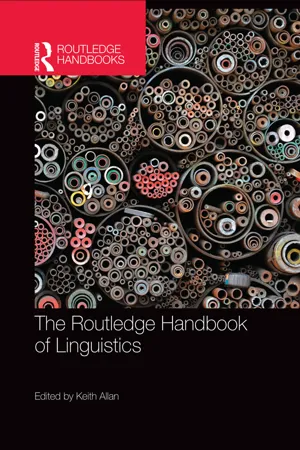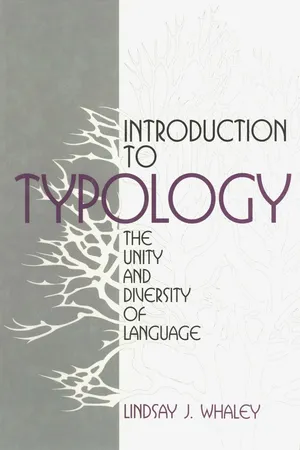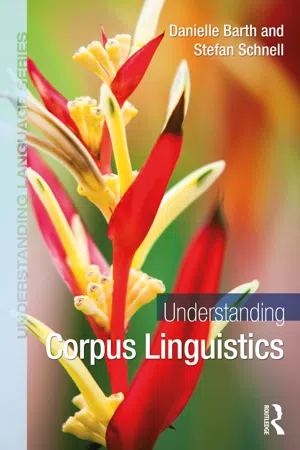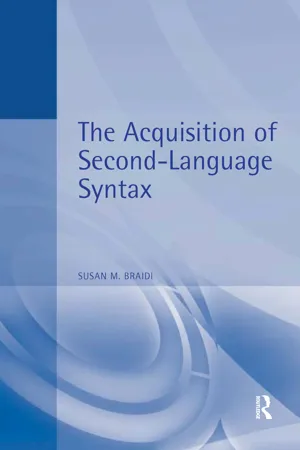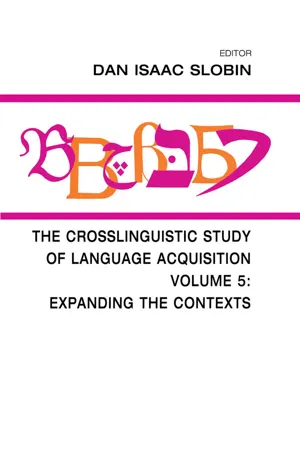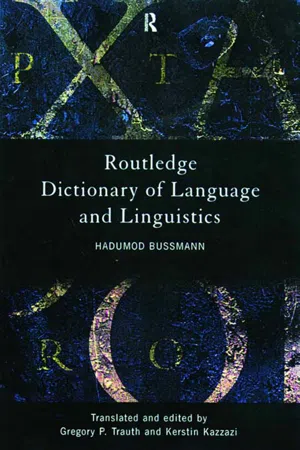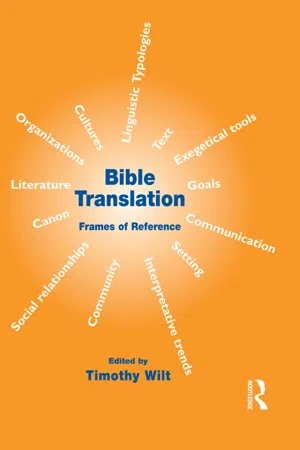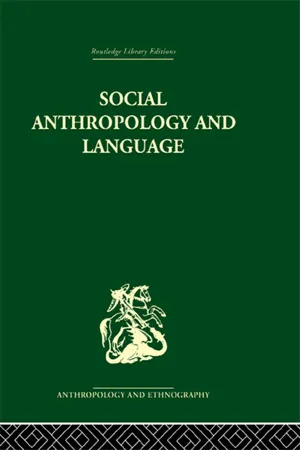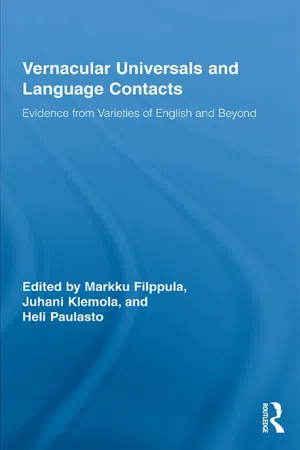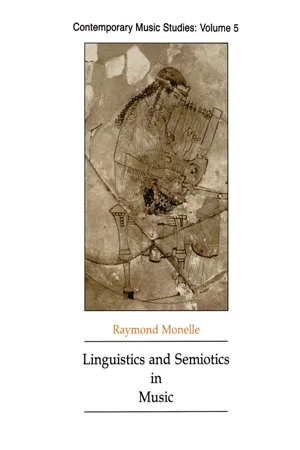Languages & Linguistics
Typology
Typology in linguistics refers to the classification and comparison of languages based on their structural features. It involves identifying and categorizing linguistic patterns and structures across different languages to understand their similarities and differences. Typological studies help linguists gain insights into the universal principles underlying language and the diversity of linguistic systems.
Written by Perlego with AI-assistance
Related key terms
Related key terms
1 of 4
Related key terms
1 of 3
10 Key excerpts on "Typology"
- eBook - ePub
- Keith Allan, Keith Allan(Authors)
- 2015(Publication Date)
- Routledge(Publisher)
25 Linguistic Typology and language universals Jae Jung Song 25.1 Introduction Linguistic Typology is a theoretical approach to the study of human language, with sophisticated methods and an impressive body of knowledge. The primary objective of linguistic Typology is to study the structural variation within human language with a view to establishing limits on this variation and seeking explanations for the limits. Thus, practitioners of linguistic Typology – or linguistic typologists – tend to work with a large number of languages in their research, typically asking ‘what is possible, as opposed to impossible, in human language?’ or, more modestly, ‘what is more probable, as opposed to less probable, in human language?’ Linguistic Typology has a long tradition dating back to the nineteenth-century European interests in genealogical relationships among languages and in the evolution of human language or, as some historians of linguistics suggest, its origin may go even further back to other European scholarly traditions in the seventeenth or eighteenth centuries. The term ‘Typology’ (or Typologie in German), in the context of the study of human language, was coined by the German philologist and sinologist Georg von der Gabelentz (1840–1893) to give a name to what was then still an emerging approach to the study of human language. The linguistic Typology adopted in the nineteenth century was essentially the morphological Typology, in which three basic strategies in the formal encoding of relational meaning were recognized: inflectional, agglutinating and isolating – a fourth, incorporating, was later added to this Typology. Though initially embraced by scholars with enthusiasm, linguistic Typology soon came to be subsumed under or overshadowed by other interests, i.e. historical linguistics in particular - eBook - ePub
Introduction to Typology
The Unity and Diversity of Language
- Lindsay J. Whaley(Author)
- 1996(Publication Date)
- SAGE Publications, Inc(Publisher)
Which explanation for the similarities between languages is right? In all likelihood, the unity of language, and consequent language universals, arises from a slate of interacting factors, some innate, others functional, and still others cognitive, experiential, social, or historical. What this means in practical terms is that there are a number of legitimate ways to approach the question, “What is language?” This book examines the nature of language from a “typological” approach. In the following section, a better sense for what this means is developed.1.0. Defining “Typology”
What exactly is meant by Typology in the context of linguistics? In its most general sense, Typology is(2) The classification of languages or components of languages based on shared formal characteristics. As a point of departure, it is important to note that Typology is not a theory of grammar.3 Unlike Government and Binding Theory, Functional Grammar, Cognitive Grammar, Relational Grammar, or the many other frameworks that are designed to model how language works, Typology has the goal of identifying cross-linguistic patterns and correlations between these patterns. For this reason, the methodology and results of typological research are in principle compatible with any grammatical theory. The relationship between Typology and theories of grammar is further explored later in this chapter and in Chapter 3 .Having described something that Typology is not, we now must come to understand what it is. There are three significant propositions packed into the dense definition in (2): (a) Typology utilizes cross-linguistic comparison, (b) Typology classifies languages or aspects of languages, and (c) Typology examines formal features of languages. These parts of the definition will be examined one at a time with an eye to better understanding what is involved in performing language Typology.Proposition 1: Typology involves cross-linguistic comparison.Ultimately, all typological research is based on comparisons between languages. Consider the following data:(3) a. I met the man who taught you French. b. The dog which licked Cora has become her friend. c. I sent the story to the newspaper - eBook - ePub
- Danielle Barth, Stefan Schnell(Authors)
- 2021(Publication Date)
- Routledge(Publisher)
11 Corpus-based TypologyDOI: 10.4324/9780429269035-11KEYWORDS Keywords Language Processing Biases Speech Rate and Pausing Preferred Argument Structure Word Order Referential Density Parallel, Parallax, and Original Text Corpora Multilingual Corpus Design Social Cognition Typology of Language Use11.1 Introduction: Typological questions and linguistic corpora
As linguists, we are interested in the properties of all human languages. The subdiscipline of linguistics that deals with worldwide linguistic diversity is linguistic Typology. Typologists compare languages to establish what they all have in common and to understand to what extent they are different. Modern typologists focus on specific structural features: for example, what word order is most common cross-linguistically? What is the distribution of word order across language families and linguistic areas, and why? The core question in modern distributional Typology is, therefore, ‘what is where and why?’ (Bickel 2007 , 2015 ). These new developments in Typology go beyond the structuralist tradition in linguistics, considering aspects of cultural diversity and migration history, neuro- and psycholinguistics, language acquisition, and also corpus linguistics.Traditional Typology has been based on abstract features of languages understood as abstract systems, for example, what case marking languages possess or which word order. In some work each language as a whole is treated as representative of one feature value, for example, a specific number of cases. A finer-grained approach is multivariate Typology where features are differentiated according to construction types (Bickel 2015 :906–911). Most of this typological work is based on descriptive accounts of languages like published grammar, but also particular expert information on specific topics. Data on specific features are collated in databases that form the basis for statistical analyses of feature distributions, for example, the World Atlas of Linguistic Structures (Dryer & Haspelmath 2013 ). The approach we outline in this chapter takes corpora as the basis for linguistic Typology, and we call this approach corpus-based Typology (CBT) following Haig et al. (2011) . In CBT, languages are considered from the perspective of language use, and it investigates the use of different linguistic structures in specific communicative and discourse contexts, and as characteristics of discourse production more generally. Influential corpora that have been used or developed for typological research include (cf. Chapter 3 - eBook - ePub
- Susan Braidi(Author)
- 2020(Publication Date)
- Routledge(Publisher)
4 Typological universals 4.1 Introduction Research on linguistic universals can focus on different aspects of universality, and, in fact, in the previous chapters we have seen different perspectives on the notion of universals: universal constraints on the form of human languages both native languages and interlanguages - and universal processes in the acquisition of both LI and L2 languages. There are also diverse approaches to examining and defining linguistic universals. While researchers of linguistic universals may ultimately strive to answer the same question - 'What is a possible human language?' (Croft 1990) - the investigative approaches, or how one goes about arriving at an answer to the question, may differ. Researchers of typological universals attempt to answer this question by examining a selection of structures from a wide range of diverse languages from the different language families in order to form a broad base of cross-linguistic data. From this data-based or inductive approach, statements of linguistic universals are then developed. In one of the seminal works on universals of language, Greenberg (1966b) offers 45 universals of grammar based on typological analyses. This approach contrasts with work in Universal Grammar (UG), which originally focused on an in-depth analysis of a single language in order to form a theory of human language. Thus, research in L2 acquisition of typological universals represents another view of universals in L2 grammatical development. The interest in the role of tyaological universale in L2 acquisition grew out of two bodies of research: (1) theoretical work on typological universals, and (2) the examination of transfer and developmental errors in L2 acquisition. As we have seen in Chapter 2, the early L2-acquisition work on transfer and developmental errors generated many of the questions addressed in the subsequent L2-acquisition research in the UG approach - eBook - ePub
The Crosslinguistic Study of Language Acquisition
Volume 5: Expanding the Contexts
- Dan Isaac Slobin(Author)
- 2014(Publication Date)
- Psychology Press(Publisher)
The first volume of this series begins with the following statement: “It is the burden of the present collection of studies to demonstrate that crosslinguistic study does more than reveal uniformities of development, because properties of individual languages influence the course of development…. One cannot study universals without exploring particulars” (Slobin, 1985b, p. 4). This theme is amply demonstrated in the 35 chapters of these five volumes. However, in recent years, a third term has been added to the old pair, “universal and particular.” This term is TYPOLOGICAL. It appears explicitly in the title of Ann Peters’ chapter in this volume, “Language Typology, Prosody, and the Acquisition of Grammatical Morphemes,” and it is implicit in chapters in other volumes: Eve Clark’s chapter on Romance languages (Clark, 1985), Kim Plunkett and Sven Strömqvist’s chapter on Scandinavian languages (Plunkett & Strömqvist, 1992), Lisa Dasinger’s chapter on Finno-Ugric languages (Dasinger, 1997), and Robert Van Valin’s chapter on ergative languages (Van Valin, 1992). Underlying all of these chapters is a common position with regard to the limits on linguistic diversity: It is, by now, taken as given that the languages of the world represent a varying collection of exemplars of a single universal pattern. However, it has also become evident that the universal pattern allows for systematic constraints on variation. The results of such constraints make it possible to group languages into types, defined by their positions on various parameters or dimensions. This insight is as central to the principles-and-parameters approach as it is to functionalist-typological linguistics.The pairing of universal and typological is evident in the titles of two important textbooks: Bernard Comrie’s (1981) Language Universals and Linguistic Typology and William Croft’s (1990) Typology and Universals . Linguistic Typology has become an increasingly active field. In 1982, John Benjamins Publishing Company initiated a major series under the heading “Typological Studies in Language”; more recently, in 1994, Oxford University Press announced a new series, “Oxford Studies in Typology and Linguistic Theory.” In the same year, a new linguistic association arose, the Association for Linguistic Typology, which attracted a rapidly growing membership even before it became formally organized, and which has launched a new journal, Linguistic Typology .In a charter statement for the association, Frans Plank and Johan van der Auwera (e-mail, March 1994) succinctly state the central mission as “the charting of crosslinguistic diversity and the empirical determination of its principled limitations.” Thus the detailed description of particular languages must also attend to universal principles of variation. These principles, then, become part of the theory of human language. I would phrase the mission of the crosslinguistic study of child language in like terms: THE CHARTING OF CROSSLINGUISTIC DIVERSITY IN LANGUAGE ACQUISITION and THE EMPIRICAL DETERMINATION OF ITS PRINCIPLED LIMITATIONS - eBook - ePub
- Hadumod Bussmann, Kerstin Kazzazi, Gregory Trauth, Kerstin Kazzazi, Gregory Trauth(Authors)
- 2006(Publication Date)
- Routledge(Publisher)
In this early stage of language Typology, value judgments were also attached to each type: the richness of forms in the inflectional languages was considered a sign of greater development, while the isolating and agglutinating languages were seen as less developed stages on their way to becoming inflectional languages. For a history of the research on language Typology, see Haarman (1976). The main objections against this traditional, primarily morphological, Typology are based on the lack of theoretical agreement about the nature of the elements (such as syllable, morpheme, word) and properties (such as intonation, concatenation) in question, as well as its too categorical (as opposed to gradual) nature, which does not sufficiently take into consideration the interdependence of phonological, morphological, and syntactic criteria. The syntactic approaches to Typology owe the most to Greenberg (1963), who developed a Typology of word order types (⇒ universals). Other syntactic properties, such as the system of grammatical relations (e.g. ergative vs nominative languages) have also been used as the basis for language Typology. For more recent approaches and terminological suggestions, see Altmann and Lehfeldt (1973), Lehmann (1978), and Vennemann (1982). References Altmann, G. and W.Lehfeldt. 1973. Allgemeine Sprachtypologie: Prinzipien und Meβverfahren. Munich. Comrie, B. 1981. Language universals and language Typology. Oxford. (2nd edn 1989.) Croft, W. 1990. Typology and universals. Cambridge. Finck, F.N. 1909. Die Haupttypen des Sprachbaus. Leipzig. (Repr. 5th edn Darmstadt, 1965.) Greenberg, J.H. 1960. A quantitative approach to the morphological Typology of language. IJAL 26. ——1963. Some universals of grammar with particular reference to the order of meaningful elements. In his Universals of language. Cambridge. ——1974. Language Typology: a historical and analytical overview. The Hague. Haarman, H - eBook - ePub
Bible Translation
Frames of Reference
- Timothy Wilt(Author)
- 2014(Publication Date)
- Routledge(Publisher)
Because translation requires moving the categories of the alien system into those of our own, this imposes constraints on how radically different the alien system can be. If completely incompatible, even partial translation should be impossible. The fact that a fair degree of translation between conceptual schemes across languages and cultures does seem possible indicates that at least some minimal communalities (sic) do exist. But this should not blind us to the wide gulf between them. Quine emphasizes that languages are systems; we are not trying to match the meanings of words across the systems, but the conceptual schemes these belong to – a much taller order, as this implies aligning the systems as wholes.Mismatching conceptual schemata between source and target languages are a source of problems for the translator that need to be addressed in any theory of translation. And learning to identify them and deal with them should be a part of any translator’s training.4.2 TypologyLinguistic Typology attempts to lump languages into types on the basis of structural commonalities. Nowadays Typology is concerned with practically all aspects of language, even at the discourse level.4.2.1 Constituent order TypologyOne of the most traditional concerns of linguistic Typology has been the order of constituents at the clause level or words at the phrase level. At the clause level, the overwhelming majority of the world’s languages have one of the following three basic (i.e. unmarked) constituent orders: Verb Subject Object (VSO), Subject Verb Object (SVO) or Subject Object Verb (SOV). This does not mean, for example, that in a VSO language, only that order occurs. It means that it is the unmarked, most neutral, most expected order in that language, and that when speakers deviate from it, they are communicating something of pragmatic import to the hearer. English is now an SVO language, but certainly other marked orders are possible and occur all the time, as can be seen from examples 1a-b:- [1]
- I like guacamole (SVO)
- Guacamole I like (OSV)
These two sentences are semantically identical, but pragmatically distinct and would be used in different contextual circumstances. It would behoove a translator who is translating from an SVO language like Spanish into, say, a VSO language like Garifuna (Arawak, Honduras) to be acutely aware of this typological difference. Garifuna permits SVO when there is a pragmatic need to confer special prominence on the subject. However, it is easy to imagine the disastrous consequences of a Garifuna translator’s ingenuously reproducing the unmarked SVO order of Spanish as a marked - eBook - ePub
- Edwin Ardener(Author)
- 2013(Publication Date)
- Routledge(Publisher)
Apart from the specific ‘meanings’ which may attach to certain selections at the purely phonological level, such as onomatopoeia and suprasegmental patterns of rhythm, pitch, stress, and quantity, the main function of the phonology is to provide the differential means of constructing discrete morphological units. The essential function of grammar and lexis is to provide sufficient items and operations in the linguistic expression to distinguish between what we would normally think of as different meanings – though not, of course, on a one-for-one basis. Language simply could not perform its communicative function without these levels of organization. At first sight, however, there would appear to be no logical necessity for further organization into separate diatypes, so far as the basic communication of thoughts and intentions is concerned. Yet it appears likely that all speech communities do in fact have diatypic conventions 5 over and above the indispensable primary conventions of phonology, grammar, and lexis. There is at present no reason to believe that the former are any less arbitrary; yet the fact that diatypic distinctions seem to be universally present suggests that they reflect a universal factor in human affairs: and that factor is the presence of systems of social attitudes which imply a social analysis and categorization of situations by participants over and above the primary semantic analysis presupposed by any linguistic text in an act of communication. One may establish a difference between diatypic and stylistic variation parallel to the difference between dialect and idiolect. A diatype implies a conventional connection of a language variety with a given category or categories of situation. In order to communicate without risk of misunderstanding, members of a linguistic community must submit to diatypic convention just as they must submit to the primary linguistic conventions of phonological, grammatical, and lexical rules - eBook - ePub
Vernacular Universals and Language Contacts
Evidence from Varieties of English and Beyond
- Markku Filppula, Juhani Klemola, Heli Paulasto(Authors)
- 2009(Publication Date)
- Routledge(Publisher)
horror aequi , weight, as well as some others. Recent scholarship in language Typology has produced the notions of semantic maps and cognitive space (Croft 2004; Haspelmath 1997), which represent powerful cognitive constraints on the structure of language.5. LINGUISTIC UNIVERSALS AND VARIETIES OF ENGLISHAs we have seen, linguistic universals are domain-specific and to a large extent disjunctive relative to these domains. In this section, I will argue that varieties of English (i.e. vernacular data) are also highly heterogeneous, and that any attempt to apply universals research to varieties of English must take these differences into consideration.Varieties of English across the globe can be classified in different ways, but as far as I can see, we can distinguish at least the following major types:The differences between and across varieties of English are frequently underestimated in the quest for their universal structural properties. I believe that it is vital to assess the sociocultural and historical background of each variety. This is mainly for three reasons: (1) different types of varieties may give rise to different types of universals, (2) different universals may be in need of different explanations, and (3) even the same phenomena in different varieties may be in need of different explanations.1. Native Englishes— British English — North American English — English of Australia and New Zealand — South African English2. Shift varieties— Irish English — Singapore English — Indian South African English3. L2 varieties— Singapore English — Indian English — many African Englishes4. Creole Englishes (Tok Pisin, Sranan, Saramaccan, etc.) 5. Various Pidgin Englishes - eBook - ePub
- Raymond Monelle(Author)
- 2014(Publication Date)
- Routledge(Publisher)
Linguistic and Structuralist Theory, from Saussure to Piaget2.1. Philology and Linguistics2.1.1. It would be difficult to understand the methodology and technical language of semiotics without a grasp of the main traditions in linguistics, and the whole theory of structuralism which grew there from. Ideas like the syntagm and paradigm , the conception of synchronic versus diachronic analysis, transformation and generation are parts of the essential method of semiotics, and must be approached through linguistics.2.1.2. The study of language in the nineteenth century was mainly concerned with comparative philology. This was essentially a historical study and it owed its origin largely to a realization that Latin and Greek, clearly related to each other, were also related to Sanskrit, and that behind the three languages lay a lost original language which was called ‘Indo-European’. A consideration of grammar and phonology made possible the drawing-up of family trees of languages, which were thus classified into groups.All linguistic questions were approached from the historical standpoint. In the case of word-meanings this led to an emphasis on etymology, and here one of the dangers of the philological approach can be observed. A word form or usage that does not take account of history may be considered ‘incorrect’. For example, the common spelling extrovert is sometimes condemned because of the Latin background of the word, the very uncommon extravert being preferred. This attitude is clearly normative.2.2. Saussure2.2.1. The Swiss linguist Ferdinand de Saussure brought about a linguistic revolution by dividing the historical view of language, which he called diachronic , from the view of language as a self-consistent system viewed at one moment of time, called synchronic. The speakers of a language may not know about its history but they are conversant with the structure of the language as it exists at this moment. Saussure did not publish his ideas, but notes were taken from his lectures at the University of Geneva from 1906 to 1911 and these were published after his death in 1915 as the Cours de Linguistique Générale.
Index pages curate the most relevant extracts from our library of academic textbooks. They’ve been created using an in-house natural language model (NLM), each adding context and meaning to key research topics.
Explore more topic indexes
Explore more topic indexes
1 of 6
Explore more topic indexes
1 of 4
